Friday, December 31, 2010
Towards a New Iron Curtain: The US-NATO Missile Shield Encircles Eurasia
By Mahdi Darius Nazemroaya
December 28, 2010
Western Europe through NATO and the E.U. forms the primary bridgehead of America into Eurasia.
According to Brzezinski: “[NATO and the E.U. constitute] America’s most important global relationship. It is the springboard for U.S. global involvement, enabling America to play the decisive role of arbiter in Eurasia — the world’s central arena of power — and it creates a coalition that is globally dominant in all key dimensions of power and influence.” [1]
The secondary bridgeheads of America into Eurasia are: (1) Japan and South Korea; (2) the Arabian Peninsula; and (3) the U.S. and NATO military forces in occupied Iraq and Afghanistan.
This is why the expansion of the U.S. missile shield from a U.S. project to a NATO project should come as no surprise. The globalization of NATO isd part of that process. The inclusion of the missile shield project under the helm of NATO was already in the pipeline in the 1990s. In fact, the statements that NATO just adopted the missile shield project in 2010 are bold faced lies.
U.S. and NATO Missile Proliferation
Records of active NATO missile system proliferation go all the way back to 2006 with the Active Layered Theatre Ballistic Missile Defence (ALTBMD) program. Within NATO, the U.S., Britain, Denmark, France, Germany, Italy, the Netherlands, Poland, and the Czech Republic have been working together for years in establishing a missile shield system. While Israel, India, Australia, Taiwan, Japan, and Ukraine under its former Orangist government have all been partners.
NATO even drafted a missile coordination policy in the same year as the Anglo-American invasion of Iraq, 2003. The draft was ratified by NATO the next year, in 2004. France was also working on its own ballistic missile (SAMP-T) system, while the Dutch, Germans, and Americans were jointly developing the integrated Extended Air/Theater Missile systems through Project Optic Windmill.
"The Ring of Fire" and the New Iron Curtain: The Three Theatres of the Inter-Continental Missile Shield Project
The missile shield project is really a triad of three missile shields that form a global missile shield system surrounding Eurasia. The three theatre segments of the missile shield are based in Europe, the Middle East, and East Asia. East Asia includes both Northeast Asia and Southeast Asia. Moreover, there are also overlapping zones that link the triad of missile shields. These are: (1) the Mediterranean, which links Europe and the Middle East; (2) the Indian Ocean, which links the Middle East and East Asia; and (3) North America.
North America acts as the strategic depth of this weapons system and in reality is its command centre. The system is linked to North American missile defences over the U.S., Canada, and Greenland. North America also serves to augment the missile systems in both East Asia and Europe.
While Iran has been cited as a justification for a missile shield in Europe, the location of military facilities in Greenland says something else. Geographically, Greenland is not a proper location to monitor any possible North Korean missile threat or located in the best place to monitor any possible Iranian missile threat. Greenland is ideal for monitoring Russian missiles that would travel over the Arctic Circle as the most logical route.
The European missile project is primarily aimed at Russia, while the East Asian missile project is aimed primarily at China under the pretext of defence against North Korea. The Middle Eastern portion of the missile project is in Israel and the Persian Gulf, hosted by countries like Saudi Arabia, and aimed at Iran and Syria. The establishment of a missile shield in Turkey will primarily be aimed against Iran and Syria and will also provide the cover for an Israeli attempt to attack Iran. In this context, many voices in Turkey have been raised in opposition to Turkish participation in the NATO missile shield project. This includes the leader of the People’s Voice Party of Turkey who has said that the missile shield project could lead to World War III. [2]
From New Iron Curtain to Star Wars: The Militarization of Space
In regards to the Asiatic missile project, Australia has also been working with the U.S. and Japan. There is also a drive to raise a missile shield in South Asia with India. This effectively means that Eurasia would be encircled by a ring of missile systems.
This is also why Russia has been working closely with its allies in Kazakhstan, Belarus, and China on missile defences and China has developed a missile system that can destroy US-NATO satellites.
The multi-layered U.S. and NATO global missile shield system is tied into to the militarization of space.
Western Europe through NATO and the E.U. forms the primary bridgehead of America into Eurasia.
According to Brzezinski: “[NATO and the E.U. constitute] America’s most important global relationship. It is the springboard for U.S. global involvement, enabling America to play the decisive role of arbiter in Eurasia — the world’s central arena of power — and it creates a coalition that is globally dominant in all key dimensions of power and influence.” [1]
The secondary bridgeheads of America into Eurasia are: (1) Japan and South Korea; (2) the Arabian Peninsula; and (3) the U.S. and NATO military forces in occupied Iraq and Afghanistan.
This is why the expansion of the U.S. missile shield from a U.S. project to a NATO project should come as no surprise. The globalization of NATO isd part of that process. The inclusion of the missile shield project under the helm of NATO was already in the pipeline in the 1990s. In fact, the statements that NATO just adopted the missile shield project in 2010 are bold faced lies.
U.S. and NATO Missile Proliferation
Records of active NATO missile system proliferation go all the way back to 2006 with the Active Layered Theatre Ballistic Missile Defence (ALTBMD) program. Within NATO, the U.S., Britain, Denmark, France, Germany, Italy, the Netherlands, Poland, and the Czech Republic have been working together for years in establishing a missile shield system. While Israel, India, Australia, Taiwan, Japan, and Ukraine under its former Orangist government have all been partners.
NATO even drafted a missile coordination policy in the same year as the Anglo-American invasion of Iraq, 2003. The draft was ratified by NATO the next year, in 2004. France was also working on its own ballistic missile (SAMP-T) system, while the Dutch, Germans, and Americans were jointly developing the integrated Extended Air/Theater Missile systems through Project Optic Windmill.
"The Ring of Fire" and the New Iron Curtain: The Three Theatres of the Inter-Continental Missile Shield Project
The missile shield project is really a triad of three missile shields that form a global missile shield system surrounding Eurasia. The three theatre segments of the missile shield are based in Europe, the Middle East, and East Asia. East Asia includes both Northeast Asia and Southeast Asia. Moreover, there are also overlapping zones that link the triad of missile shields. These are: (1) the Mediterranean, which links Europe and the Middle East; (2) the Indian Ocean, which links the Middle East and East Asia; and (3) North America.
North America acts as the strategic depth of this weapons system and in reality is its command centre. The system is linked to North American missile defences over the U.S., Canada, and Greenland. North America also serves to augment the missile systems in both East Asia and Europe.
While Iran has been cited as a justification for a missile shield in Europe, the location of military facilities in Greenland says something else. Geographically, Greenland is not a proper location to monitor any possible North Korean missile threat or located in the best place to monitor any possible Iranian missile threat. Greenland is ideal for monitoring Russian missiles that would travel over the Arctic Circle as the most logical route.
The European missile project is primarily aimed at Russia, while the East Asian missile project is aimed primarily at China under the pretext of defence against North Korea. The Middle Eastern portion of the missile project is in Israel and the Persian Gulf, hosted by countries like Saudi Arabia, and aimed at Iran and Syria. The establishment of a missile shield in Turkey will primarily be aimed against Iran and Syria and will also provide the cover for an Israeli attempt to attack Iran. In this context, many voices in Turkey have been raised in opposition to Turkish participation in the NATO missile shield project. This includes the leader of the People’s Voice Party of Turkey who has said that the missile shield project could lead to World War III. [2]
From New Iron Curtain to Star Wars: The Militarization of Space
In regards to the Asiatic missile project, Australia has also been working with the U.S. and Japan. There is also a drive to raise a missile shield in South Asia with India. This effectively means that Eurasia would be encircled by a ring of missile systems.
This is also why Russia has been working closely with its allies in Kazakhstan, Belarus, and China on missile defences and China has developed a missile system that can destroy US-NATO satellites.
The multi-layered U.S. and NATO global missile shield system is tied into to the militarization of space.
Mahdi Darius Nazemroaya is a Research Associate at the
Centre for Research on Globalization (CRG).
© Copyright Mahdi Darius Nazemroaya, Global Research, 2010
The url address of this article is: www.globalresearch.ca/index.php?context=va&aid=22365
NOTES
[1] Zbigniew Brzezinski, The Geostrategic Triad: Living with China, Europe, and Russia (Washington, D.C.: Center for Strategic and International Studies Press, November 3, 2000), p.29.
[2] Serkan Demirta?, “NATO shield could cause World War III, Turkish party leader says”, Hürriyet Daily News and Economic Review, November 24, 2010.
__________________________________
Related & recommended; also by Mahdi Darius Nazemroaya,
The Israeli war on the Gaza Strip -"The Birth Pangs of a New Palestine/Middle East”
The British Foreign Policy towards the Palestinian Issue with Special Reference to Resolution 242
by John McHugo
This document was presented by Mr. John McHugo at the Conference on "The Eurpean Foreign Policy towards the Palestinian Issue" that was held by Al-Zaytouna Centre for Studies and Consultations in Beirut, on 3-4/11/2010
The Balfour Declaration
Britain has had a longer involvement with the Palestine issue than any other Western country, going back to the Balfour Declaration. This is not a history lecture, and I take a background in the basic history of the Palestinian issue for granted when addressing this distinguished audience, but I would like to begin by drawing attention to a certain vagueness, an imprecision, in that specifically British document: the Balfour Declaration in 1917.
The Declaration begins by stating that “His Majesty’s Government view with favour the establishment in Palestine of a national home for the Jewish people, and will use their best endeavours to facilitate the achievement of this object....” It then continues with a safeguard: “it being clearly understood that nothing shall be done which may prejudice the civil and religious rights of existing non-Jewish communities in Palestine...”
The single sentence that makes up the declaration is stuffed full of ambiguity and a lack of clarity. “Palestine” is not defined, and there was no single Turkish administrative unit or group of administrative units that could be said to unambiguously constitute “Palestine” in 1917. “Palestine” is therefore unclear. It is also unclear whether the intention is that the declaration should apply to the whole of “Palestine” or just a part of it. Perhaps even more crucially, it did not say what it meant by “a Jewish national home”. Note that it did not say “the Jewish national home”.
The words “national” and “home” are not spelled with capital letters, so there is no reason why it should not just have been referring to one of several “Jewish national homes”. Another element of lack of clarity is introduced by “the Jewish people”. Note also that, once again, there is no capital letter before the noun “people”.
Did Balfour mean by his “national home” for the Jewish people a sovereign, independent State? This is far from clear from the text of the Declaration itself, and at least one key British official, Sir Ronald Storrs, was able to delude himself that a sovereign Jewish State was “just the idea of a few extremists” among the Zionists. One could indeed argue that the safeguard in the Declaration “nothing shall be done which may prejudice the civil and religious rights of existing non-Jewish communities in Palestine” might suggest a Jewish sovereign state was never intended.
Constructive Ambiguity
Nevertheless, we all know that the establishment of a predominantly or exclusively Jewish State was always the intention of the Zionist leadership. The lack of clarity in the Balfour Declaration gave them an open door at which they could push. Perhaps, over half a century before Henry Kissinger, it was a case of so-called constructive ambiguity.
The idea behind constructive ambiguity is that wording is agreed that will allow each party to maintain a position which is incompatible with that of the other party. Each party’s face is thus saved for the time being, and – if we are optimistic - perhaps other points of disagreement will be resolved, thus defusing the contentious issue. It may even happen that the importance of the contentious issue will diminish with the passage of time, and it will become irrelevant.
Nevertheless, the risks are great: hopes that the contentious issue will be subsequently resolved may be dashed, and these shattered hopes may cause the acrimonious breakdown of negotiations. Each party may become more entrenched in its own view of the contentious issue as time passes, which may make a resumption of serious negotiations harder. Even worse, constructive ambiguity can lead to perceptions of bad faith and a breakdown in trust between negotiators.
I came across a case in which this happened when I was working on the boundaries between two Gulf states. A no doubt well-meaning but slightly devious and not very intelligent British political officer brokered an agreement between two rulers. This agreement was written in 1944 - again, well before Henry Kissinger, the arch-practitioner of “constructive ambiguity”. It was an agreement for a return to a status quo ante, with neither party accepting the claims of the other. It was a disaster, and led to a breakdown of trust and much acrimony over the next two generations.
Resolution 242 as another example of constructive ambiguity
I will now fast forward to Resolution 242 and ask whether the same ambiguity and lack of clarity can be found in it as in the Balfour Declaration, because the question unfortunately needs to be posed: has Britain’s policy on the Palestine issue been tainted throughout with constructive ambiguity, and is Resolution 242, exactly half a century after the Balfour Declaration, another example of it? Certainly, 242 is frequently cited as an example of constructive ambiguity, and many discussions of constructive ambiguity, including the Wikipedia entry on the topic, begin with an examination of 242 as a case study.
My analysis of the text
Nevertheless, as some of you may know, I made the case some eight years ago in the International and Comparative Law Quarterly that 242 is a clear and unambiguous document. I will pause here to summarise the arguments I adduced in 2002:
(1) The crucial wording is the phrase “Withdrawal of Israel (sic) armed forces from territories occupied in the recent conflict”. Now the absence of the words “all” or “the” in front of “territories” does not mean that the words “some of the” should be supplied instead. To infer that less than total withdrawal was intended by this wording would establish a very dangerous precedent. In my article I suggested an imaginary notice: “Dogs must be kept on the lead near ponds in the park” as an example to prove my point. Common sense tells us that the notice applies to all dogs and to all ponds.
I still stand by my example, but you might like also to consider the wording of the armistice agreement that ended fighting on the western front at the end of the First World War. It is entitled “Conditions of an Armistice with Germany”. Article One reads as follows: “Cessation of hostilities on land and in the air six hours after the signature of the Armistice”. Did this mean “a complete cessation” or “a partial cessation”? Did it refer to “all land” or to “some land”? Did it refer to “all the air” or just “some of the air”? Could anyone seriously suggest it only intended a partial cessation of some, but not all, hostilities? Obviously, the answer to all these questions is “no”. The actual wording of the Withdrawal phrase in 242 does not, I submit, imply that a partial withdrawal is the intention. This is my first argument.
(2) My second argument is as follows. The wording of the Withdrawal phrase must be interpreted in the light of both the immediate context in which it occurs (the text of the Resolution when taken as a whole) and the less immediate context (the statements made in the Security Council debate and the battle of drafts in the history of the drafting process – the travaux prepratoires). Both contexts, I argue, support my interpretation. These statements and the travaux preparatoires make the intentions of the members of the Security Council clear, and my analysis passes the test contained in the rules of interpretation set out in Articles 30-3 of the 1969 Vienna Convention.
(3) My third argument is of a general nature. A clear interpretation -if it is possible to arrive at one- must be preferred over an ambiguous one. The Israeli interpretation was inherently ambiguous, but I believe that I showed conclusively that there was no need to reach an ambiguous interpretation since a clear interpretation was available. Therefore, it is wrong in principle to prefer the ambiguous interpretation.
In addition to these three arguments, which are really three limbs of one single argument, there was yet another argument set out in my article. This that the words “Withdrawal of Israel forces” refers to troop movements, nothing more. The question of territorial sovereignty is dealt with elsewhere in the Resolution, in the words “Emphasising the inadmissibility of the acquisition of territory by war” which incorporate a provision of customary international law directly into the Resolution. This wording provides that Israel cannot acquire sovereignty over occupied territory by unilateral acts. It means that, even if Israel’s argument over the Withdrawal Phrase were sustainable, it would be irrelevant.
The lack of reaction
After my article appeared, I waited to see what the reaction would be. The article was well-received by some scholars, and the Negotiations Affairs Department of the PLO obtained permission from the publishers for it to be placed on their web-site. But did it lead to a debate? No, it did not. As this conference is about European policy – as well as British policy – you may be interested that in June 2007 the highly respected Konrad Adenauer Stiftung organised a conference in Jerusalem on Resolution 242 jointly with Dore Gold’s self-styled Jerusalem Center for Public Affairs.
It was an egregious Propagandafest, if you will excuse my language. There was no serious attempt to investigate what 242 really meant: it was an occasion for what I have called the Right-wing Israeli interpretation of the withdrawal provision in 242 to be celebrated and uncritically propagated to the world. Rather than attempt to deal with my arguments, the organisers of the conference ignored them.
Michael Lynk’s work
The Canadian scholar Michael Lynk revisited 242 in 2007 in his article Conceived in Law: the legal foundations of Resolution 242. He went into the question more thoroughly than I had done in 2002 and came to broadly the same conclusion as myself. He looks at the attempt by scholars favourable to the official Israeli position to argue that 242, “does not compel Israel to make more than a partial withdrawal from the captured territories; that the waging of a defensive or pre-emptive war does not force Israel to surrender the lands that it conquered; and that Israel’s occupation is legal until a final peace agreement establishes ‘secure and recognised borders’.”
His analysis of their work shows how these scholars who have attempted to give respectability to the Israeli position have only been able to do so “by cherry-picking the diplomatic record and diluting the liberal purposes of modern international law”. Like the speakers at the 2007 conference in Jerusalem, they can only do this by ignoring and refusing to engage with the arguments which their opponents – such as Lynk and myself – have produced. As Lynk has eloquently put it, “In all of the 1967 territories, Israel settled its civilians in state-subsidized colonies as a prelude to claiming permanent control and title over the lands, an act expressly forbidden by international law. Israel remains in deliberate non-compliance with a number of clearly expressed Security Council resolutions that flow from 242, including its annexations of East Jerusalem and the Golan Heights, and its civilian settlements in the occupied territories.
Viewed through this good faith requirement, Israel’s constricted interpretation and application of the withdrawal provision is less the product of a genuine and rationally-held (albeit minority) interpretation of international law, and more the disfigured reading of law to justify the deliberate evasion of legal responsibilities.”
I believe that my work and that of Lynk has shown that there is a real difference between the Balfour Declaration and 242. The latter is clear, the former is not.
Pushing at an open door
During the Mandate, the Zionist leadership used the text of the Balfour Declaration as an open door at which it could push. The ambiguities of the Declaration led to the acceptance by the Mandatory authorities that the Jewish Yishuv and the Palestinian Arabs should be treated as two separate peoples, to the first proposal for partition of Palestine by the Peel Commission in 1937, to the abandonment of the 1939 White Paper, to the UN partition resolution and ultimately to the establishment of the state of Israel. It was successful in gaining these advantages precisely because of the Declaration’s ambiguity.
Israel tries to do the same today with Resolution 242. It uses its interpretation to back up its propaganda campaign that it has the right to annex parts of the territories it occupied in 1967. The ambiguity which Israel claims to find in Resolution 242 thus lies behind its illegal annexation of Jerusalem, its sectarian settlement policy, its pillaging of the occupied territories of their resources, and its blatantly racist attempts to draw a distinction between the land of the territories and the indigenous people who inhabit it.
I strongly suspect that it is because of this alleged constructive ambiguity that Israel has agreed to the use of Resolution 242 as the basis of attempts to negotiate peace. Indeed, perhaps this is a successful example of “constructive ambiguity” in its true, if cynical, meaning. Thus, there is a special reference to 242 in the preamble to the 1979 Israel-Egypt peace treaty, while Article 1 of the Declaration of Principles between Israel and the PLO of 13 September 1993 begins by stating that the negotiations “will lead to the implementation of Security Council Resolutions 242 and 338”. I strongly suspect that Israel was happy to accept the reference to 242 in the 1993 Declaration of Principles precisely because it believed this gave it an open door at which it could push.
When constructive ambiguity is not ambiguous
But, as has been shown above, the truth of the matter is that Resolution 242 is incapable of sustaining the Israeli interpretation. This brings us to two questions:
(1) What is the position when a party decides to rely on what it considers to be constructive ambiguity, but there is actually no constructive ambiguity in the case in question – or it subsequently transpires that it was mistaken in its view that there was constructive ambiguity?
(2) What is the position when that party relies on alleged constructive ambiguity for its own, self-seeking purposes, and is able to do so to the detriment of the other party because it is politically and militarily by far the stronger?
The answer to the first question is, I think, simple. If two parties to an agreement dispute its meaning and go to court – perhaps years after the agreement was signed – they are bound by the meaning which the court finds to be the right one, and must implement it. This is surely self-evident. A mistaken interpretation of Resolution 242 cannot be used by Israel to support policies which are unacceptable in terms of the text of the resolution, or under international law.
By arguing a position of ambiguity, and relying on its own interpretation of the ambiguity to the detriment of the other party, I would also suggest it should be precluded, or estopped, from denying the rights which the true meaning of the resolution accords to the other party.
We need to look more closely at the second question. The Zionist exploitation of the ambiguity in the Balfour Declaration was successful because the Zionists were the stronger party viz a viz the Palestinian Arabs, something that is amply demonstrated by their ability to bring greater influence to bring to bear on the conduct of the Mandatory power than the Palestinian Arabs, as well as by the Zionist successes in the fighting on the ground during the last six months of the Mandate.
The future state of Israel would be the beneficiary of all this. Now the fact that Israel is today a sovereign state for the purposes of international law, and the fact that the PLO has accepted the 1949 cease-fire lines in a manner that constitutes a waiver of Palestinian claims to sovereignty over the territory on the Israeli side of those lines, mean that the ambiguity of the Balfour Declaration is no longer of relevance in the search for a peace settlement.
But what about Resolution 242? If the Yishuv was the stronger party during the Mandate, how much more powerful is Israel compared to the Palestinians during the period from 1967 until today! In its attempts to use 242 as an open door at which it can push, Israel has been systematically abusing its position as an occupying power in international law.
Yet the Security Council, in its subsequent pronouncements, has left Israel no wiggle-room. The Resolutions condemning Israel’s purported annexation of East Jerusalem and the Golan Heights all re-iterate the principle of the inadmissibility of the acquisition of territory by war – in other words, they are consistent with the interpretation of Resolution 242 which both Lynk and I have put forward, but not with that of Israel.
Although the provision in the Resolution which calls for every state in the area to have “the right to live in peace within secure and recognised boundaries free from threats or acts of force” may lead to a renegotiation of boundaries, and some diplomats involved in negotiating Resolution 242 (including the British representative, Lord Caradon) subsequently stated that the old armistice lines needed adjustment, only adjustments which are on the basis of freely agreed territorial swaps would be consistent with Resolution 242.
British policy
This brings us, at last, to British policy. What is Britain’s position on Resolution 242? On two separate occasions in the Security Council debate Lord Caradon, stated that the wording was clear. He also implied (in his comments on the Latin American draft Resolution which expressly provided for a complete withdrawal) that he supported a complete withdrawal, and explicitly linked the withdrawal phrase with the emphasis on the inadmissibility of the acquisition of territory by war in the preamble, both of which provisions he regarded as “clear”.
On this basis, I felt confident stating in my ICLQ article that Britain was one of the ten members of the Security Council that went on the record to the effect that the Resolution gave Israel no right to acquire any of the territories it occupied in 1967. We must now ask, does subsequent British policy confirm this?
To answer this question, I searched under Resolution 242 on the Foreign and Commonwealth Office’s web-site, because I am well aware that all statements put on the web-site will have been carefully scrutinised to ensure that they reflect current government policy. I also looked at Dr Rosemary Hollis’ s study, Britain and the Middle East in the 9/11 Era, which was published this spring and deals with Britain’s policy towards the Peace Process, Iraq and other questions concerning the Middle East throughout the premiership of Tony Blair.
I found twenty-two references to Resolution 242 on the FCO web-site. They were all published on it during the period 2008-10 and are thus positions which the British government wishes to emphasise today, although some of them are statements by British ministers made on earlier occasions going back to 2002. Most of them need not detain us, and are merely statements to the effect that Resolution 242 is one of the foundations for a just peace, but without specifying what it provides.
Thus, David Miliband, the British Foreign Secretary, stated that Resolutions 242 and 338 provided “the agreed foundation for progress” at the Annapolis summit in 2007. Yet, interestingly, his predecessor, Jack Straw, stated at a reception in 2002 that a comprehensive settlement between Israel and Palestine should involve a two state solution “with borders based on Security Council Resolutions 242 and 338”, and the Israeli country profile on the web-site is adamant that the British government’s view is that the provisions concerning withdrawal of Israeli troops apply to East Jerusalem.
These seem to me to point to my interpretation of 242 being shared by the British government. Jack Straw did, however, spell this out a little more in the parliamentary debate before the vote was taken to invade Iraq on 26 February 2003. Trying to defend Britain against the charge of double standards over Palestine, he said:
“We deal with this charge, however, not by ignoring outstanding United Nations obligations, but working ever harder to see them all implemented. The key ones on Israel/Palestine – 242, 338, 1397 – impose obligations on three sets of parties, on the Palestinians to end terrorism, on the Arab countries to end the support of terrorism and to recognise the State of Israel, on Israel fully to cooperate in the establishment of a viable State of Palestine with borders broadly based on those of 1967...”[emphasis added]
Even more significant, is the report of an interview given by the British Consul-General in Jerusalem, Mr Barry Marston, to Al Quds newspaper on 30 May 2006 contains the following, highly significant statement in response to a question about settlements: “All settlements on the Palestinian territories are illegal. UN Resolution 242 calls for the dismantling of the settlements”.
Now you know as well as I do that the words “dismantle” and “settlements” do not occur in Resolution 242. What was Mr Marston referring to? It can only have been to the following position, which we are entitled to assume is that of the British government: Resolution 242 forbids the acquisition of territory by war. This therefore makes all the settlements automatically illegal, and Israel is under an obligation to dismantle them. No arguments brought on the basis of Israel’s spurious and dishonest interpretation of the Withdrawal phrase in 242 can affect this.
Conclusion
International humanitarian law, in the form of Article 49(6) of the Fourth Geneva Convention of 1949, of course also prohibits an occupying power from transferring its civilian population into occupied territory. Mr Marston could have referred to this provision if he had wished, and it would have given him sufficient authority for his assertion. But he chose instead to base his statement on Resolution 242.This can only have been intentional. It shows that the British Government’s policy is to uphold the clear and unambiguous effect of Resolution 242 which I have set out above. Wouldn’t it be wonderful if the British Government could take just one more small step and say this in so many words?
The Declaration begins by stating that “His Majesty’s Government view with favour the establishment in Palestine of a national home for the Jewish people, and will use their best endeavours to facilitate the achievement of this object....” It then continues with a safeguard: “it being clearly understood that nothing shall be done which may prejudice the civil and religious rights of existing non-Jewish communities in Palestine...”
The single sentence that makes up the declaration is stuffed full of ambiguity and a lack of clarity. “Palestine” is not defined, and there was no single Turkish administrative unit or group of administrative units that could be said to unambiguously constitute “Palestine” in 1917. “Palestine” is therefore unclear. It is also unclear whether the intention is that the declaration should apply to the whole of “Palestine” or just a part of it. Perhaps even more crucially, it did not say what it meant by “a Jewish national home”. Note that it did not say “the Jewish national home”.
The words “national” and “home” are not spelled with capital letters, so there is no reason why it should not just have been referring to one of several “Jewish national homes”. Another element of lack of clarity is introduced by “the Jewish people”. Note also that, once again, there is no capital letter before the noun “people”.
Did Balfour mean by his “national home” for the Jewish people a sovereign, independent State? This is far from clear from the text of the Declaration itself, and at least one key British official, Sir Ronald Storrs, was able to delude himself that a sovereign Jewish State was “just the idea of a few extremists” among the Zionists. One could indeed argue that the safeguard in the Declaration “nothing shall be done which may prejudice the civil and religious rights of existing non-Jewish communities in Palestine” might suggest a Jewish sovereign state was never intended.
Constructive Ambiguity
Nevertheless, we all know that the establishment of a predominantly or exclusively Jewish State was always the intention of the Zionist leadership. The lack of clarity in the Balfour Declaration gave them an open door at which they could push. Perhaps, over half a century before Henry Kissinger, it was a case of so-called constructive ambiguity.
The idea behind constructive ambiguity is that wording is agreed that will allow each party to maintain a position which is incompatible with that of the other party. Each party’s face is thus saved for the time being, and – if we are optimistic - perhaps other points of disagreement will be resolved, thus defusing the contentious issue. It may even happen that the importance of the contentious issue will diminish with the passage of time, and it will become irrelevant.
Nevertheless, the risks are great: hopes that the contentious issue will be subsequently resolved may be dashed, and these shattered hopes may cause the acrimonious breakdown of negotiations. Each party may become more entrenched in its own view of the contentious issue as time passes, which may make a resumption of serious negotiations harder. Even worse, constructive ambiguity can lead to perceptions of bad faith and a breakdown in trust between negotiators.
I came across a case in which this happened when I was working on the boundaries between two Gulf states. A no doubt well-meaning but slightly devious and not very intelligent British political officer brokered an agreement between two rulers. This agreement was written in 1944 - again, well before Henry Kissinger, the arch-practitioner of “constructive ambiguity”. It was an agreement for a return to a status quo ante, with neither party accepting the claims of the other. It was a disaster, and led to a breakdown of trust and much acrimony over the next two generations.
Resolution 242 as another example of constructive ambiguity
I will now fast forward to Resolution 242 and ask whether the same ambiguity and lack of clarity can be found in it as in the Balfour Declaration, because the question unfortunately needs to be posed: has Britain’s policy on the Palestine issue been tainted throughout with constructive ambiguity, and is Resolution 242, exactly half a century after the Balfour Declaration, another example of it? Certainly, 242 is frequently cited as an example of constructive ambiguity, and many discussions of constructive ambiguity, including the Wikipedia entry on the topic, begin with an examination of 242 as a case study.
My analysis of the text
Nevertheless, as some of you may know, I made the case some eight years ago in the International and Comparative Law Quarterly that 242 is a clear and unambiguous document. I will pause here to summarise the arguments I adduced in 2002:
(1) The crucial wording is the phrase “Withdrawal of Israel (sic) armed forces from territories occupied in the recent conflict”. Now the absence of the words “all” or “the” in front of “territories” does not mean that the words “some of the” should be supplied instead. To infer that less than total withdrawal was intended by this wording would establish a very dangerous precedent. In my article I suggested an imaginary notice: “Dogs must be kept on the lead near ponds in the park” as an example to prove my point. Common sense tells us that the notice applies to all dogs and to all ponds.
I still stand by my example, but you might like also to consider the wording of the armistice agreement that ended fighting on the western front at the end of the First World War. It is entitled “Conditions of an Armistice with Germany”. Article One reads as follows: “Cessation of hostilities on land and in the air six hours after the signature of the Armistice”. Did this mean “a complete cessation” or “a partial cessation”? Did it refer to “all land” or to “some land”? Did it refer to “all the air” or just “some of the air”? Could anyone seriously suggest it only intended a partial cessation of some, but not all, hostilities? Obviously, the answer to all these questions is “no”. The actual wording of the Withdrawal phrase in 242 does not, I submit, imply that a partial withdrawal is the intention. This is my first argument.
(2) My second argument is as follows. The wording of the Withdrawal phrase must be interpreted in the light of both the immediate context in which it occurs (the text of the Resolution when taken as a whole) and the less immediate context (the statements made in the Security Council debate and the battle of drafts in the history of the drafting process – the travaux prepratoires). Both contexts, I argue, support my interpretation. These statements and the travaux preparatoires make the intentions of the members of the Security Council clear, and my analysis passes the test contained in the rules of interpretation set out in Articles 30-3 of the 1969 Vienna Convention.
(3) My third argument is of a general nature. A clear interpretation -if it is possible to arrive at one- must be preferred over an ambiguous one. The Israeli interpretation was inherently ambiguous, but I believe that I showed conclusively that there was no need to reach an ambiguous interpretation since a clear interpretation was available. Therefore, it is wrong in principle to prefer the ambiguous interpretation.
In addition to these three arguments, which are really three limbs of one single argument, there was yet another argument set out in my article. This that the words “Withdrawal of Israel forces” refers to troop movements, nothing more. The question of territorial sovereignty is dealt with elsewhere in the Resolution, in the words “Emphasising the inadmissibility of the acquisition of territory by war” which incorporate a provision of customary international law directly into the Resolution. This wording provides that Israel cannot acquire sovereignty over occupied territory by unilateral acts. It means that, even if Israel’s argument over the Withdrawal Phrase were sustainable, it would be irrelevant.
The lack of reaction
After my article appeared, I waited to see what the reaction would be. The article was well-received by some scholars, and the Negotiations Affairs Department of the PLO obtained permission from the publishers for it to be placed on their web-site. But did it lead to a debate? No, it did not. As this conference is about European policy – as well as British policy – you may be interested that in June 2007 the highly respected Konrad Adenauer Stiftung organised a conference in Jerusalem on Resolution 242 jointly with Dore Gold’s self-styled Jerusalem Center for Public Affairs.
It was an egregious Propagandafest, if you will excuse my language. There was no serious attempt to investigate what 242 really meant: it was an occasion for what I have called the Right-wing Israeli interpretation of the withdrawal provision in 242 to be celebrated and uncritically propagated to the world. Rather than attempt to deal with my arguments, the organisers of the conference ignored them.
Michael Lynk’s work
The Canadian scholar Michael Lynk revisited 242 in 2007 in his article Conceived in Law: the legal foundations of Resolution 242. He went into the question more thoroughly than I had done in 2002 and came to broadly the same conclusion as myself. He looks at the attempt by scholars favourable to the official Israeli position to argue that 242, “does not compel Israel to make more than a partial withdrawal from the captured territories; that the waging of a defensive or pre-emptive war does not force Israel to surrender the lands that it conquered; and that Israel’s occupation is legal until a final peace agreement establishes ‘secure and recognised borders’.”
His analysis of their work shows how these scholars who have attempted to give respectability to the Israeli position have only been able to do so “by cherry-picking the diplomatic record and diluting the liberal purposes of modern international law”. Like the speakers at the 2007 conference in Jerusalem, they can only do this by ignoring and refusing to engage with the arguments which their opponents – such as Lynk and myself – have produced. As Lynk has eloquently put it, “In all of the 1967 territories, Israel settled its civilians in state-subsidized colonies as a prelude to claiming permanent control and title over the lands, an act expressly forbidden by international law. Israel remains in deliberate non-compliance with a number of clearly expressed Security Council resolutions that flow from 242, including its annexations of East Jerusalem and the Golan Heights, and its civilian settlements in the occupied territories.
Viewed through this good faith requirement, Israel’s constricted interpretation and application of the withdrawal provision is less the product of a genuine and rationally-held (albeit minority) interpretation of international law, and more the disfigured reading of law to justify the deliberate evasion of legal responsibilities.”
I believe that my work and that of Lynk has shown that there is a real difference between the Balfour Declaration and 242. The latter is clear, the former is not.
Pushing at an open door
During the Mandate, the Zionist leadership used the text of the Balfour Declaration as an open door at which it could push. The ambiguities of the Declaration led to the acceptance by the Mandatory authorities that the Jewish Yishuv and the Palestinian Arabs should be treated as two separate peoples, to the first proposal for partition of Palestine by the Peel Commission in 1937, to the abandonment of the 1939 White Paper, to the UN partition resolution and ultimately to the establishment of the state of Israel. It was successful in gaining these advantages precisely because of the Declaration’s ambiguity.
Israel tries to do the same today with Resolution 242. It uses its interpretation to back up its propaganda campaign that it has the right to annex parts of the territories it occupied in 1967. The ambiguity which Israel claims to find in Resolution 242 thus lies behind its illegal annexation of Jerusalem, its sectarian settlement policy, its pillaging of the occupied territories of their resources, and its blatantly racist attempts to draw a distinction between the land of the territories and the indigenous people who inhabit it.
I strongly suspect that it is because of this alleged constructive ambiguity that Israel has agreed to the use of Resolution 242 as the basis of attempts to negotiate peace. Indeed, perhaps this is a successful example of “constructive ambiguity” in its true, if cynical, meaning. Thus, there is a special reference to 242 in the preamble to the 1979 Israel-Egypt peace treaty, while Article 1 of the Declaration of Principles between Israel and the PLO of 13 September 1993 begins by stating that the negotiations “will lead to the implementation of Security Council Resolutions 242 and 338”. I strongly suspect that Israel was happy to accept the reference to 242 in the 1993 Declaration of Principles precisely because it believed this gave it an open door at which it could push.
When constructive ambiguity is not ambiguous
But, as has been shown above, the truth of the matter is that Resolution 242 is incapable of sustaining the Israeli interpretation. This brings us to two questions:
(1) What is the position when a party decides to rely on what it considers to be constructive ambiguity, but there is actually no constructive ambiguity in the case in question – or it subsequently transpires that it was mistaken in its view that there was constructive ambiguity?
(2) What is the position when that party relies on alleged constructive ambiguity for its own, self-seeking purposes, and is able to do so to the detriment of the other party because it is politically and militarily by far the stronger?
The answer to the first question is, I think, simple. If two parties to an agreement dispute its meaning and go to court – perhaps years after the agreement was signed – they are bound by the meaning which the court finds to be the right one, and must implement it. This is surely self-evident. A mistaken interpretation of Resolution 242 cannot be used by Israel to support policies which are unacceptable in terms of the text of the resolution, or under international law.
By arguing a position of ambiguity, and relying on its own interpretation of the ambiguity to the detriment of the other party, I would also suggest it should be precluded, or estopped, from denying the rights which the true meaning of the resolution accords to the other party.
We need to look more closely at the second question. The Zionist exploitation of the ambiguity in the Balfour Declaration was successful because the Zionists were the stronger party viz a viz the Palestinian Arabs, something that is amply demonstrated by their ability to bring greater influence to bring to bear on the conduct of the Mandatory power than the Palestinian Arabs, as well as by the Zionist successes in the fighting on the ground during the last six months of the Mandate.
The future state of Israel would be the beneficiary of all this. Now the fact that Israel is today a sovereign state for the purposes of international law, and the fact that the PLO has accepted the 1949 cease-fire lines in a manner that constitutes a waiver of Palestinian claims to sovereignty over the territory on the Israeli side of those lines, mean that the ambiguity of the Balfour Declaration is no longer of relevance in the search for a peace settlement.
But what about Resolution 242? If the Yishuv was the stronger party during the Mandate, how much more powerful is Israel compared to the Palestinians during the period from 1967 until today! In its attempts to use 242 as an open door at which it can push, Israel has been systematically abusing its position as an occupying power in international law.
Yet the Security Council, in its subsequent pronouncements, has left Israel no wiggle-room. The Resolutions condemning Israel’s purported annexation of East Jerusalem and the Golan Heights all re-iterate the principle of the inadmissibility of the acquisition of territory by war – in other words, they are consistent with the interpretation of Resolution 242 which both Lynk and I have put forward, but not with that of Israel.
Although the provision in the Resolution which calls for every state in the area to have “the right to live in peace within secure and recognised boundaries free from threats or acts of force” may lead to a renegotiation of boundaries, and some diplomats involved in negotiating Resolution 242 (including the British representative, Lord Caradon) subsequently stated that the old armistice lines needed adjustment, only adjustments which are on the basis of freely agreed territorial swaps would be consistent with Resolution 242.
British policy
This brings us, at last, to British policy. What is Britain’s position on Resolution 242? On two separate occasions in the Security Council debate Lord Caradon, stated that the wording was clear. He also implied (in his comments on the Latin American draft Resolution which expressly provided for a complete withdrawal) that he supported a complete withdrawal, and explicitly linked the withdrawal phrase with the emphasis on the inadmissibility of the acquisition of territory by war in the preamble, both of which provisions he regarded as “clear”.
On this basis, I felt confident stating in my ICLQ article that Britain was one of the ten members of the Security Council that went on the record to the effect that the Resolution gave Israel no right to acquire any of the territories it occupied in 1967. We must now ask, does subsequent British policy confirm this?
To answer this question, I searched under Resolution 242 on the Foreign and Commonwealth Office’s web-site, because I am well aware that all statements put on the web-site will have been carefully scrutinised to ensure that they reflect current government policy. I also looked at Dr Rosemary Hollis’ s study, Britain and the Middle East in the 9/11 Era, which was published this spring and deals with Britain’s policy towards the Peace Process, Iraq and other questions concerning the Middle East throughout the premiership of Tony Blair.
I found twenty-two references to Resolution 242 on the FCO web-site. They were all published on it during the period 2008-10 and are thus positions which the British government wishes to emphasise today, although some of them are statements by British ministers made on earlier occasions going back to 2002. Most of them need not detain us, and are merely statements to the effect that Resolution 242 is one of the foundations for a just peace, but without specifying what it provides.
Thus, David Miliband, the British Foreign Secretary, stated that Resolutions 242 and 338 provided “the agreed foundation for progress” at the Annapolis summit in 2007. Yet, interestingly, his predecessor, Jack Straw, stated at a reception in 2002 that a comprehensive settlement between Israel and Palestine should involve a two state solution “with borders based on Security Council Resolutions 242 and 338”, and the Israeli country profile on the web-site is adamant that the British government’s view is that the provisions concerning withdrawal of Israeli troops apply to East Jerusalem.
These seem to me to point to my interpretation of 242 being shared by the British government. Jack Straw did, however, spell this out a little more in the parliamentary debate before the vote was taken to invade Iraq on 26 February 2003. Trying to defend Britain against the charge of double standards over Palestine, he said:
“We deal with this charge, however, not by ignoring outstanding United Nations obligations, but working ever harder to see them all implemented. The key ones on Israel/Palestine – 242, 338, 1397 – impose obligations on three sets of parties, on the Palestinians to end terrorism, on the Arab countries to end the support of terrorism and to recognise the State of Israel, on Israel fully to cooperate in the establishment of a viable State of Palestine with borders broadly based on those of 1967...”[emphasis added]
Even more significant, is the report of an interview given by the British Consul-General in Jerusalem, Mr Barry Marston, to Al Quds newspaper on 30 May 2006 contains the following, highly significant statement in response to a question about settlements: “All settlements on the Palestinian territories are illegal. UN Resolution 242 calls for the dismantling of the settlements”.
Now you know as well as I do that the words “dismantle” and “settlements” do not occur in Resolution 242. What was Mr Marston referring to? It can only have been to the following position, which we are entitled to assume is that of the British government: Resolution 242 forbids the acquisition of territory by war. This therefore makes all the settlements automatically illegal, and Israel is under an obligation to dismantle them. No arguments brought on the basis of Israel’s spurious and dishonest interpretation of the Withdrawal phrase in 242 can affect this.
Conclusion
International humanitarian law, in the form of Article 49(6) of the Fourth Geneva Convention of 1949, of course also prohibits an occupying power from transferring its civilian population into occupied territory. Mr Marston could have referred to this provision if he had wished, and it would have given him sufficient authority for his assertion. But he chose instead to base his statement on Resolution 242.This can only have been intentional. It shows that the British Government’s policy is to uphold the clear and unambiguous effect of Resolution 242 which I have set out above. Wouldn’t it be wonderful if the British Government could take just one more small step and say this in so many words?
_____________________________________
John McHugo is the chair of the Liberal Democrat Friends of Palestine and a member of the Executive of the Council for Arab British Understanding (CAABU).
‘McHugo is, so far as I know, the only man to re-examine the actual UN debates on 242…a most elucidating paper…McHugo mischievously adds…’ – Robert Fisk, The Independent.
_________
pitchers tuck by buddy don: cuple of them pets
the year 2010 has bin bout the worst of my life in more ways than a bidy could count. i aint a'gone list em on a counta how i dont wonta dwell on that kinda thang. i druther thank bout good thangs, lack the way Kingsley n Miss Liberty made such good friends. Miss Liberty gits along with everbidy, but Kimono n Kingsley aint figgerd each other out yet.heres them friends:heres hopin nex year will be
Thursday, December 30, 2010
Junji Ito's Frankenstein (Excerpts)

Remember to read from right to left.



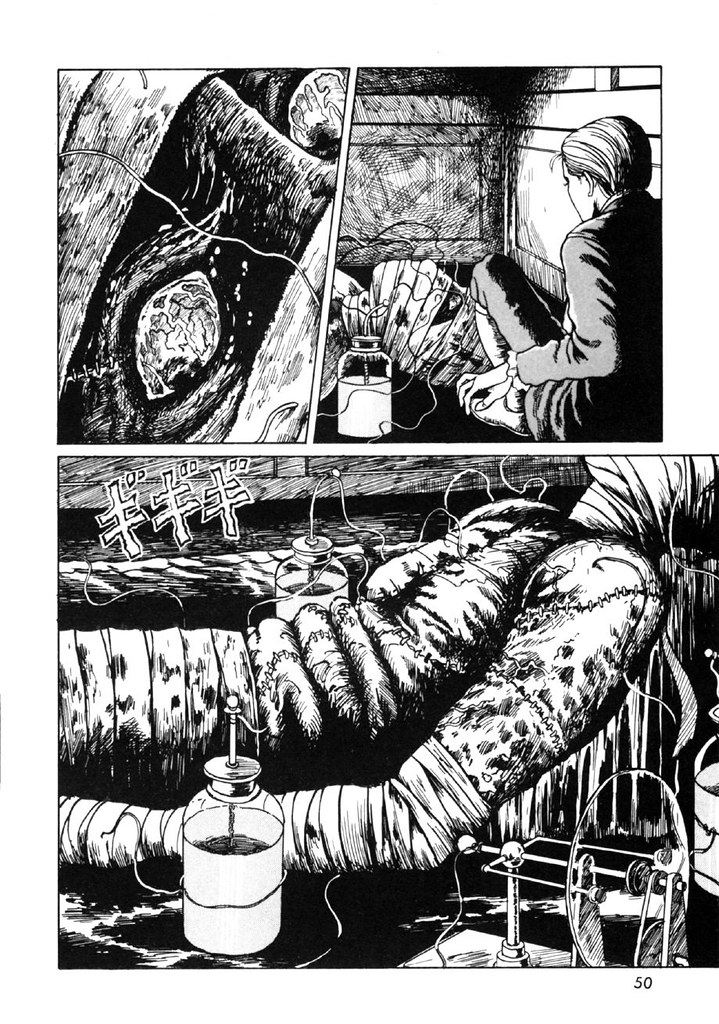







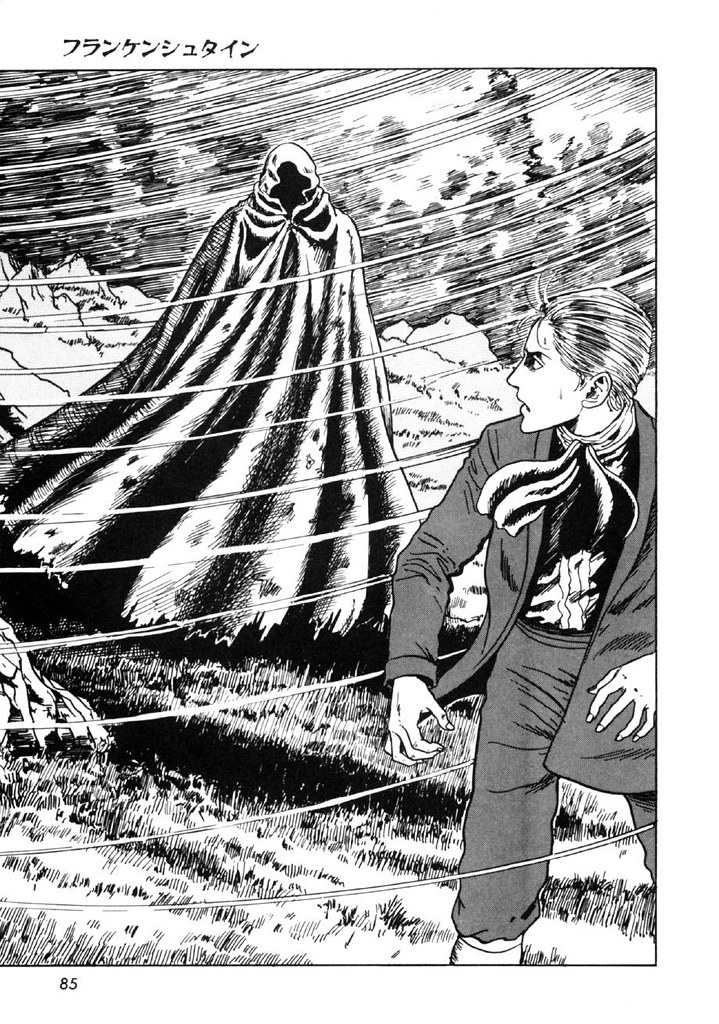











You can find the complete English translation of Junji Ito's Frankenstein here.
Previously on Monster Brains, Junji Ito's Thing That Drifted Ashore.
I encourage everyone who is a fan of Ito to purchase physical copies of his works, you can start by browsing the selection on Amazon.
The Enemy Within
.
by Jeff Gates
December 30 2011
Jeff Gates is author of Guilt By Association – How Deception and Self-Deceit Took America to War. See www.criminalstate.com
_______________________________________________________
by Jeff Gates
December 30 2011
The phrase “enemy within” brings to mind the image of a shadowy spy stealing military secrets. That was the case for Israeli master spy Jonathan Pollard jailed for 1980s espionage that compromised U.S. Cold War strategy.
That phrase also describes those involved in a form of psy-ops that is not easily detected because it operates so brazenly. For instance, the well-timed release of diplomatic cables by WikiLeaks displaced reports of Israeli obstinacy in peace talks with reports of a need for war with Iran.
That operation relied on editors at four major newspapers chosen by WikiLeaks to manage the releases. Despite the delight at their impact voiced by Israeli Prime Minister Benjamin Netanyahu, mainstream media failed to mention the possibility of undisclosed bias by those who chose what to release and when.
The bias of The New York Times is well known. Less clear is the role of Ian Katz, Deputy Editor at The Guardian (London) and Executive Editor Sylvie Kauffman at Le Monde in Paris. The geopolitical success of the WikiLeaks operation suggests an enemy within.
Israeli duplicity often operates through what U.S. Defense Secretary Robert Gates describes as “the people in between.” When waging unconventional warfare, those people are the most dangerous combatants, particularly those operatives in mainstream media.
The People in Between
For systems of governance reliant on informed consent, nothing could be more perilous. The “people in between” routinely target media—freedom’s greatest vulnerability—as a means for displacing facts with what a targeted populace can be deceived to believe.
How old is this duplicity? How long have false beliefs been used to manipulate behavior? Modern technology—particularly media—enables deception on a global scale. Between the American populace and the facts they require to protect their freedom—that’s where this enemy within imbeds its operatives.
The false intelligence claiming Iraqi WMD was a people-in-between operation. Judith Miller at The New York Times fed us a steady diet of front-page news that we now know was fixed around Israeli goals promoted by Ahmad Chalabi, a London-based Iraqi expatriate who, like Israel, sought regime change in Iraq.
Pentagon insider Richard Perle developed Chalabi over two decades. A Jewish Zionist, Perle has long been a strategically well-placed “person in between.” Miller left The Times and joined Fox News and then Newsmax.
Yet the impact of complicit media pales in comparison to the enemy within that brought the U.S. economy to its knees and undermined national security at its financial core.
Imbedded Inside
The most devastating in this chronicle of enemies is the most difficult to see. As with other “in between” operations, this too succeeds by displacing facts with false beliefs. Only in this case, those beliefs were imbedded in education and over decades worked their way into law.
Known as the “Washington Consensus,” this widely shared perspective shapes economic policy worldwide. At the heart of this generally accepted truth is found the belief that money should be accountable only to itself.
In this mindset, financial freedom is an article of faith. Instead of the civil rights refrain, “Let my people go,” its proponents insist: “Let my money go.” Allow money the freedom to work its will worldwide and everything will work out fine.
That shared belief works “in between” in the same way that Jonathan Pollard undermined national security, WikiLeaks shifted attention to Iran and Judith Miller induced us to war in Iraq. Only in this case a false belief has been so thoroughly internalized that it’s difficult to see because this shared mindset has become that with which we have been educated do our seeing.
A Global Sanhedrin
The World Bank and the International Monetary Fund are the primary apostles of this consensus faith. The World Trade Organization (WTO) now seeks to take this belief to global scale by enforcing unrestricted free trade not only in goods and services but also financial capital.
The WTO operates like a global Sanhedrin akin to a Jewish high council accountable only to itself. What’s now emerging as a global enemy within is a finance-guided form of transnational governance marketed as free trade but accountable only to itself.
That 'self’ traces its origins to an internalized mindset in which financial freedom serves, by consensus, as a proxy for personal freedom. That mindset was decades in the making.
This modern-day Mindset Warfare is being waged by an enemy that is truly within. Fast globalizing financial forces now induce us to freely embrace the very forces that undermine our freedom.
By waging war on us from the inside out, the originators of this money-myopic mindset dismantled the U.S. economy, enabled vast financial pillaging and induced us to fiscal ruin.
Those wielding this weaponry operate from our internal shadows as the Zionist entity within.
That phrase also describes those involved in a form of psy-ops that is not easily detected because it operates so brazenly. For instance, the well-timed release of diplomatic cables by WikiLeaks displaced reports of Israeli obstinacy in peace talks with reports of a need for war with Iran.
That operation relied on editors at four major newspapers chosen by WikiLeaks to manage the releases. Despite the delight at their impact voiced by Israeli Prime Minister Benjamin Netanyahu, mainstream media failed to mention the possibility of undisclosed bias by those who chose what to release and when.
The bias of The New York Times is well known. Less clear is the role of Ian Katz, Deputy Editor at The Guardian (London) and Executive Editor Sylvie Kauffman at Le Monde in Paris. The geopolitical success of the WikiLeaks operation suggests an enemy within.
Israeli duplicity often operates through what U.S. Defense Secretary Robert Gates describes as “the people in between.” When waging unconventional warfare, those people are the most dangerous combatants, particularly those operatives in mainstream media.
The People in Between
For systems of governance reliant on informed consent, nothing could be more perilous. The “people in between” routinely target media—freedom’s greatest vulnerability—as a means for displacing facts with what a targeted populace can be deceived to believe.
How old is this duplicity? How long have false beliefs been used to manipulate behavior? Modern technology—particularly media—enables deception on a global scale. Between the American populace and the facts they require to protect their freedom—that’s where this enemy within imbeds its operatives.
The false intelligence claiming Iraqi WMD was a people-in-between operation. Judith Miller at The New York Times fed us a steady diet of front-page news that we now know was fixed around Israeli goals promoted by Ahmad Chalabi, a London-based Iraqi expatriate who, like Israel, sought regime change in Iraq.
Pentagon insider Richard Perle developed Chalabi over two decades. A Jewish Zionist, Perle has long been a strategically well-placed “person in between.” Miller left The Times and joined Fox News and then Newsmax.
Yet the impact of complicit media pales in comparison to the enemy within that brought the U.S. economy to its knees and undermined national security at its financial core.
Imbedded Inside
The most devastating in this chronicle of enemies is the most difficult to see. As with other “in between” operations, this too succeeds by displacing facts with false beliefs. Only in this case, those beliefs were imbedded in education and over decades worked their way into law.
Known as the “Washington Consensus,” this widely shared perspective shapes economic policy worldwide. At the heart of this generally accepted truth is found the belief that money should be accountable only to itself.
In this mindset, financial freedom is an article of faith. Instead of the civil rights refrain, “Let my people go,” its proponents insist: “Let my money go.” Allow money the freedom to work its will worldwide and everything will work out fine.
That shared belief works “in between” in the same way that Jonathan Pollard undermined national security, WikiLeaks shifted attention to Iran and Judith Miller induced us to war in Iraq. Only in this case a false belief has been so thoroughly internalized that it’s difficult to see because this shared mindset has become that with which we have been educated do our seeing.
A Global Sanhedrin
The World Bank and the International Monetary Fund are the primary apostles of this consensus faith. The World Trade Organization (WTO) now seeks to take this belief to global scale by enforcing unrestricted free trade not only in goods and services but also financial capital.
The WTO operates like a global Sanhedrin akin to a Jewish high council accountable only to itself. What’s now emerging as a global enemy within is a finance-guided form of transnational governance marketed as free trade but accountable only to itself.
That 'self’ traces its origins to an internalized mindset in which financial freedom serves, by consensus, as a proxy for personal freedom. That mindset was decades in the making.
This modern-day Mindset Warfare is being waged by an enemy that is truly within. Fast globalizing financial forces now induce us to freely embrace the very forces that undermine our freedom.
By waging war on us from the inside out, the originators of this money-myopic mindset dismantled the U.S. economy, enabled vast financial pillaging and induced us to fiscal ruin.
Those wielding this weaponry operate from our internal shadows as the Zionist entity within.
Jeff Gates is author of Guilt By Association – How Deception and Self-Deceit Took America to War. See www.criminalstate.com
_______________________________________________________
HELP !!!! - THE GULF OF MEXICO IS DYING !!!! .... A Special Report on the BP Gulf Oil Spill
by Dr. Tom Termotto
Concerned citizens of Florida - 2010-12-01
It is with deep regret that we publish this report. We do not take this responsibility lightly, as the consequences of the following observations are of such great import and have such far-reaching ramifications for the entire planet. Truly, the fate of the oceans of the world hangs in the balance, as does the future of humankind.
The Gulf of Mexico (GOM) does not exist in isolation and is, in fact, connected to the Seven Seas. Hence, we publish these findings in order that the world community will come together to further contemplate this dire and demanding predicament. We also do so with the hope that an appropriate global response will be formulated, and acted upon, for the sake of future generations. It is the most basic responsibility for every civilization to leave their world in a better condition than that which they inherited from their forbears.
After conducting the Gulf Oil Spill Remediation Conference for over seven months, we can now disseminate the following information with the authority and confidence of those who have thoroughly investigated a crime scene. There are many research articles, investigative reports and penetrating exposes archived at the following website. Particularly those posted from August through November provide a unique body of evidence, many with compelling photo-documentaries, which portray the true state of affairs at the Macondo Prospect in the GOM.
http://phoenixrisingfromthegulf.wordpress.com/
The pictorial evidence tells the whole story.
Especially that the BP narrative is nothing but a corporate-created illusion – a web of fabrication spun in collaboration with the US Federal Government and Mainstream Media. Big Oil, as well as the Military-Industrial Complex, have aided and abetted this whole scheme and info blackout because the very future of the Oil & Gas Industry is at stake, as is the future of the US Empire which sprawls around the world and requires vast amounts of hydrocarbon fuel.
Should the truth seep out and into the mass consciousness – that the GOM is slowly but surely filling up with oil and gas – certainly many would rightly question the integrity, and sanity, of the whole venture, as well as the entire industry itself. And then perhaps the process would begin of transitioning the planet away from the hydrocarbon fuel paradigm altogether.
It’s not a pretty picture.
The various pictures, photos and diagrams that fill the many articles at the aforementioned website represent photo-evidence about the true state of affairs on the seafloor surrounding the Macondo Prospect in the Mississippi Canyon, which is located in the Central Planning Area of the northern Gulf of Mexico. The very dynamics of the dramatic changes and continuous evolution of the seafloor have been captured in ways that very few have ever seen. These snapshots have given us a window of understanding into the true state of the underlying geological formations around the various wells drilled in the Macondo Prospect.
Although our many deductions may be difficult for the layperson to apprehend at first, to the trained eye these are but obvious conclusions which are simply the result of cause and effect. In other words there is no dispute around the most serious geological changes which have occurred, and continue to occur, in the region around the Macondo wells. The original predicament (an 87 day gushing well) was extremely serious, as grasped by the entire world, and the existing situation is only going to get progressively worse.
So, just what does this current picture look like. Please click on the link below to view the relevant diagrams and read the commentary:
http://phoenixrisingfromthegulf.wordpress.com/2010/08/03/an-autopsy-of-the-bp-gulf-oil-well-at-the-macondo-prospect/
As the diagrams clearly indicate, the geology around the well bore has been blown. This occurred because of drilling contiguous to a salt dome(1), as well as because of the gas explosions which did much damage to the integrity of the well casing, cementing, well bore, well head, and foundation around the well head. Eighty-seven straight days of gushing hydrocarbon effluent under great pressure only served to further undermine the entire well system. Finally, when it was capped, putting the system back under pressure forced the upsurging hydrocarbons to find weaknesses throughout the greater system, which revealed all sorts of compromised, fractured and unsettled geology through which the hydrocarbons could travel all the way to the seafloor and into the GOM.
(1)“The rock beds in the vicinity of a salt dome are highly fractured and permeable due to stress and deformation which occur as the salt dome thrusted upwards.” (Per BK Lim, Geohazards Specialist)
We also have faults* to deal with in this scenario of which there are both deep and shallow. Depending on the current vital stats of the blown out well, especially its actual depth; the number, location and severity of the breaches throughout the well system; the pressure at the wellhead; as well as the type and status of geological formations/strata it has been drilled into, these faults will become prominently configured into the future stability of the whole region. Larger faults can open up much greater opportunities for the hydrocarbons to find their way to the seafloor via cracks and crevices, craters and chasms. In fact the numerous leaks and seeps throughout the seafloor surface, which are quite apparent from various ROV live-feeds, give testimony to sub-seafloor geological formations in great turmoil and undergoing unprecedented flux.
*“Once the oil gets into the shallow faulted zones, we have an uncontrollable situation. The place where most of the oil and gas is coming out is at the foot hills of the continental shelf as shown in figure 134-1 in the article “BP continues to dazzle us with their unlimited magic”. The discovery by WHOI of the 22 mile long river of oil originated from these leaks. So the leaks will be mainly along the faults where I have marked (shallow) in “What is going on at West Sirius” and deep strike-slip faults (red line) on fig 134-1.” (Per BK Lim, Geohazards Specialist)
Just how bad is this situation?
There are actually three different ongoing disasters – each more grave and challenging than the previous one – which must be considered when assessing the awesome destruction to the GOM by the Oil & Gas Industry.
I. A single gushing well at 7o – 100,000 barrels per day of hydrocarbon effluent for 87 days into the GOM at the Macondo Prospect along with two smaller rogue wells
II. Numerous leaks and seeps within five to ten square miles of the Macondo well with an aggregate outflow of an unknown amount of hydrocarbon effluent per day into the GOM
III. Countless gushers and spills, leaks and seeps, throughout the Gulf of Mexico, where drilling has been conducted for many decades, with an aggregate outflow that can not even be estimated, but is well in excess of any guesstimate which would ensure the slow and steady demise of the GOM.
It is the last scenario which we all face and to which there is no easy or obvious solution. The truth be told, there currently does not exist the technology or machinery or equipment to repair the damage that has been wrought by the process of deep undersea drilling, especially when it is performed in the wrong place. Therefore, wherever the oil and gas find points of entry into the GOM through the seafloor, these leaks and seeps will only continue to get worse. Here’s why:
Methane gas mixed with saltwater and mud makes for a very potent corrosive agent. Under high pressure it will find every point of egress through the rock and sediment formations all the way up to the seafloor where it will find any point of exit that is available. The longer and more forcefully that it flows throughout the fractured area, which is dependent on the volume, temperature and pressure at the source of the hydrocarbons, the more its corrosive effects will widen, broaden and enlarge the channels, cracks and crevices throughout the sub-seafloor geology, thereby creating a predicament that no science, technology or equipment can remedy.
Dire realities of the methane hydrate predicament
The Macondo Prospect in the GOM is just one of many throughout the oceans of the world where the seafloor has beds of methane hydrate locked in place by very high pressure and low temperatures. Likewise, there are myriad repositories and large “reservoirs” of methane clathrates in the sub-seafloor strata, and especially within the more superficial geological formations, which are being greatly impacted by all oil and gas drilling and extraction activities. It does not take much imagination to understand how the upsurging hydrocarbons (very hot oil and gas) are quickly converting the frozen hydrates to gas, thereby causing innumerable “micro-displacements”, the cumulative effect of which will translate to larger “macro-displacements” of rock, sediment and other geological formations.
When you factor in this constant vaporization of methane hydrates/clathrates both sub-seafloor as well as those scattered around the seafloor surface to the existing scenario, this devolving situation becomes that much more difficult to effectively remedy. With the resulting shifts and resettling and reconfiguration of the entire seafloor terrain and underlying strata occurring in the wake of these dynamics, we are left with a situation that is not going to get better through the use of even more invasive technology and intrusive machinery.
Question: How many times can you grout a seafloor crack that was caused by an underlying superficial fault after drilling into an old mud volcano?
Answer: “In the attempt to seal the oil from oozing through the faults, BP resorted to high pressure grouting. Basically it is like cementing the cracks in the rock by injecting grout (cement mixture) at high pressure. The way they do this is by drilling an injection hole into the shallow rocks and pumping in the grout. The grout in “slurry” state will permeate into the cracks, cure and seal up the cracks. However it is not working because of the presence of gas and oil. It is like super-glue. You need to clean the surfaces before you apply the glue; otherwise it won’t stick and will come off eventually after a few days or weeks. That is why we can see a few blown out craters – shown in my article – Is the last rite for the Macondo Well for real?” (Per BK Lim, Geohazards Specialist)
Likewise, how do you fill a newly emerging gash in the seafloor which is caused by a deep fault due to low level seismic activity, or worse, a full blown earthquake?!
Seismic activity in the GOM and the uptick in earthquakes in the Mississippi River Basin and surrounding region
The oil and gas platforms that were in operation throughout the northern Gulf of Mexico in 2006 (per Wikipedia).
We now come to the most serious issue regarding the relentless drilling for oil and gas throughout the Gulf of Mexico. The map above clearly illustrates the density of drilling throughout the northern GOM as of 2006. Likewise, the map below demonstrates the extraordinary and increasing intensity of these very same operations off the coast of Louisiana alone.
Green lines represent active pipes (25,000 miles in all). Yellow dots represent oil rigs.
The map that follows, however, tells a story which demands the attention of every resident of the GOM coastline. The video link below the map shows the development timeline of the successively deeper wells being drilled during the last decade. Of course, with greater depths come much greater risks, as the technology and machinery have not been proportionately upgraded to accommodate the extraordinary demands and unforeseen contingencies of such a speculative and dangerous enterprise*.
*Oil and gas drilling in seawater depths of over 4000 feet, and through 15,000 to 25,000 feet of the earth’s crust and mantle, is considered extremely dangerous to those from whom reason and common sense have not yet fled.
Click on the map to enlarge.
http://www.youtube.com/watch?v=bh_wNVUx9SI
It’s critical to understand the location and current activity of the various faults which exist throughout the GOM and how they connect to the New Madrid Fault Line, as well as other major faults at much greater distance. There does appear to be a emerging uptick in earthquake activity in the greater Louisiana area, as well as contiguous regions in the GOM as demonstrated by unprecedented, albeit low level earthquakes. Correlations between these earthquakes/seismic activity and major operations at the Macondo Prospect have been alluded to in our previous postings.
Earthquake Activity in Gulf of Mexico Prompts 2003 Study for MMS
Gulf of Mexico Subsea Structures May Be in Seismic Danger Zone – Part 2
Now then, the question remains just how vulnerable has the GOM been made to a truly catastrophic event, ending up with an overwhelming displacement of water producing tidal waves, in the aftermath of an undersea earthquake.
There is no question that the ceaseless fracturing of the seafloor and fissuring of the sub-seafloor geological strata by the Oil & Gas Industry has set up a quite conducive environment for HUGE unintended consequences. We leave it up to the experts to conduct the necessary risk assessments, which will most assuredly let loose a sea of red flags about what Big Oil has done, and is currently doing, in the Gulf of Mexico. Furthermore, we are deeply concerned that, if a permanent moratorium on all new oil and gas drilling and extraction in the GOM is not put into place poste haste, the coastal communities will remain in a very precarious situation.
Worsening GOM predicament is reflective of the status quo around the globe
Now consider the following scenario: that this very same predicament, which we have all witnessed in the Gulf of Mexico, is happening wherever oil and gas drilling is conducted in the various water bodies throughout the planet. Therefore we can multiply the Macondo Prospect disaster a hundred times and still not come close to the impacts that these ongoing gushers and spills, leaks and seeps are having the world over.
Perhaps the BP Gulf Oil Spill was the defining moment in modern history when all the nations of the world community were called by Mother Earth herself to begin transitioning the planet away from the Hydrocarbon Fuel Paradigm. After all, we may never get another chance!
_______________________
The Gulf of Mexico (GOM) does not exist in isolation and is, in fact, connected to the Seven Seas. Hence, we publish these findings in order that the world community will come together to further contemplate this dire and demanding predicament. We also do so with the hope that an appropriate global response will be formulated, and acted upon, for the sake of future generations. It is the most basic responsibility for every civilization to leave their world in a better condition than that which they inherited from their forbears.
After conducting the Gulf Oil Spill Remediation Conference for over seven months, we can now disseminate the following information with the authority and confidence of those who have thoroughly investigated a crime scene. There are many research articles, investigative reports and penetrating exposes archived at the following website. Particularly those posted from August through November provide a unique body of evidence, many with compelling photo-documentaries, which portray the true state of affairs at the Macondo Prospect in the GOM.
http://phoenixrisingfromthegulf.wordpress.com/
The pictorial evidence tells the whole story.
Especially that the BP narrative is nothing but a corporate-created illusion – a web of fabrication spun in collaboration with the US Federal Government and Mainstream Media. Big Oil, as well as the Military-Industrial Complex, have aided and abetted this whole scheme and info blackout because the very future of the Oil & Gas Industry is at stake, as is the future of the US Empire which sprawls around the world and requires vast amounts of hydrocarbon fuel.
Should the truth seep out and into the mass consciousness – that the GOM is slowly but surely filling up with oil and gas – certainly many would rightly question the integrity, and sanity, of the whole venture, as well as the entire industry itself. And then perhaps the process would begin of transitioning the planet away from the hydrocarbon fuel paradigm altogether.
It’s not a pretty picture.
The various pictures, photos and diagrams that fill the many articles at the aforementioned website represent photo-evidence about the true state of affairs on the seafloor surrounding the Macondo Prospect in the Mississippi Canyon, which is located in the Central Planning Area of the northern Gulf of Mexico. The very dynamics of the dramatic changes and continuous evolution of the seafloor have been captured in ways that very few have ever seen. These snapshots have given us a window of understanding into the true state of the underlying geological formations around the various wells drilled in the Macondo Prospect.
Although our many deductions may be difficult for the layperson to apprehend at first, to the trained eye these are but obvious conclusions which are simply the result of cause and effect. In other words there is no dispute around the most serious geological changes which have occurred, and continue to occur, in the region around the Macondo wells. The original predicament (an 87 day gushing well) was extremely serious, as grasped by the entire world, and the existing situation is only going to get progressively worse.
So, just what does this current picture look like. Please click on the link below to view the relevant diagrams and read the commentary:
http://phoenixrisingfromthegulf.wordpress.com/2010/08/03/an-autopsy-of-the-bp-gulf-oil-well-at-the-macondo-prospect/
As the diagrams clearly indicate, the geology around the well bore has been blown. This occurred because of drilling contiguous to a salt dome(1), as well as because of the gas explosions which did much damage to the integrity of the well casing, cementing, well bore, well head, and foundation around the well head. Eighty-seven straight days of gushing hydrocarbon effluent under great pressure only served to further undermine the entire well system. Finally, when it was capped, putting the system back under pressure forced the upsurging hydrocarbons to find weaknesses throughout the greater system, which revealed all sorts of compromised, fractured and unsettled geology through which the hydrocarbons could travel all the way to the seafloor and into the GOM.
(1)“The rock beds in the vicinity of a salt dome are highly fractured and permeable due to stress and deformation which occur as the salt dome thrusted upwards.” (Per BK Lim, Geohazards Specialist)
We also have faults* to deal with in this scenario of which there are both deep and shallow. Depending on the current vital stats of the blown out well, especially its actual depth; the number, location and severity of the breaches throughout the well system; the pressure at the wellhead; as well as the type and status of geological formations/strata it has been drilled into, these faults will become prominently configured into the future stability of the whole region. Larger faults can open up much greater opportunities for the hydrocarbons to find their way to the seafloor via cracks and crevices, craters and chasms. In fact the numerous leaks and seeps throughout the seafloor surface, which are quite apparent from various ROV live-feeds, give testimony to sub-seafloor geological formations in great turmoil and undergoing unprecedented flux.
*“Once the oil gets into the shallow faulted zones, we have an uncontrollable situation. The place where most of the oil and gas is coming out is at the foot hills of the continental shelf as shown in figure 134-1 in the article “BP continues to dazzle us with their unlimited magic”. The discovery by WHOI of the 22 mile long river of oil originated from these leaks. So the leaks will be mainly along the faults where I have marked (shallow) in “What is going on at West Sirius” and deep strike-slip faults (red line) on fig 134-1.” (Per BK Lim, Geohazards Specialist)
Just how bad is this situation?
There are actually three different ongoing disasters – each more grave and challenging than the previous one – which must be considered when assessing the awesome destruction to the GOM by the Oil & Gas Industry.
I. A single gushing well at 7o – 100,000 barrels per day of hydrocarbon effluent for 87 days into the GOM at the Macondo Prospect along with two smaller rogue wells
II. Numerous leaks and seeps within five to ten square miles of the Macondo well with an aggregate outflow of an unknown amount of hydrocarbon effluent per day into the GOM
III. Countless gushers and spills, leaks and seeps, throughout the Gulf of Mexico, where drilling has been conducted for many decades, with an aggregate outflow that can not even be estimated, but is well in excess of any guesstimate which would ensure the slow and steady demise of the GOM.
It is the last scenario which we all face and to which there is no easy or obvious solution. The truth be told, there currently does not exist the technology or machinery or equipment to repair the damage that has been wrought by the process of deep undersea drilling, especially when it is performed in the wrong place. Therefore, wherever the oil and gas find points of entry into the GOM through the seafloor, these leaks and seeps will only continue to get worse. Here’s why:
Methane gas mixed with saltwater and mud makes for a very potent corrosive agent. Under high pressure it will find every point of egress through the rock and sediment formations all the way up to the seafloor where it will find any point of exit that is available. The longer and more forcefully that it flows throughout the fractured area, which is dependent on the volume, temperature and pressure at the source of the hydrocarbons, the more its corrosive effects will widen, broaden and enlarge the channels, cracks and crevices throughout the sub-seafloor geology, thereby creating a predicament that no science, technology or equipment can remedy.
Dire realities of the methane hydrate predicament
The Macondo Prospect in the GOM is just one of many throughout the oceans of the world where the seafloor has beds of methane hydrate locked in place by very high pressure and low temperatures. Likewise, there are myriad repositories and large “reservoirs” of methane clathrates in the sub-seafloor strata, and especially within the more superficial geological formations, which are being greatly impacted by all oil and gas drilling and extraction activities. It does not take much imagination to understand how the upsurging hydrocarbons (very hot oil and gas) are quickly converting the frozen hydrates to gas, thereby causing innumerable “micro-displacements”, the cumulative effect of which will translate to larger “macro-displacements” of rock, sediment and other geological formations.
When you factor in this constant vaporization of methane hydrates/clathrates both sub-seafloor as well as those scattered around the seafloor surface to the existing scenario, this devolving situation becomes that much more difficult to effectively remedy. With the resulting shifts and resettling and reconfiguration of the entire seafloor terrain and underlying strata occurring in the wake of these dynamics, we are left with a situation that is not going to get better through the use of even more invasive technology and intrusive machinery.
Question: How many times can you grout a seafloor crack that was caused by an underlying superficial fault after drilling into an old mud volcano?
Answer: “In the attempt to seal the oil from oozing through the faults, BP resorted to high pressure grouting. Basically it is like cementing the cracks in the rock by injecting grout (cement mixture) at high pressure. The way they do this is by drilling an injection hole into the shallow rocks and pumping in the grout. The grout in “slurry” state will permeate into the cracks, cure and seal up the cracks. However it is not working because of the presence of gas and oil. It is like super-glue. You need to clean the surfaces before you apply the glue; otherwise it won’t stick and will come off eventually after a few days or weeks. That is why we can see a few blown out craters – shown in my article – Is the last rite for the Macondo Well for real?” (Per BK Lim, Geohazards Specialist)
Likewise, how do you fill a newly emerging gash in the seafloor which is caused by a deep fault due to low level seismic activity, or worse, a full blown earthquake?!
Seismic activity in the GOM and the uptick in earthquakes in the Mississippi River Basin and surrounding region
The oil and gas platforms that were in operation throughout the northern Gulf of Mexico in 2006 (per Wikipedia).
We now come to the most serious issue regarding the relentless drilling for oil and gas throughout the Gulf of Mexico. The map above clearly illustrates the density of drilling throughout the northern GOM as of 2006. Likewise, the map below demonstrates the extraordinary and increasing intensity of these very same operations off the coast of Louisiana alone.
Green lines represent active pipes (25,000 miles in all). Yellow dots represent oil rigs.
The map that follows, however, tells a story which demands the attention of every resident of the GOM coastline. The video link below the map shows the development timeline of the successively deeper wells being drilled during the last decade. Of course, with greater depths come much greater risks, as the technology and machinery have not been proportionately upgraded to accommodate the extraordinary demands and unforeseen contingencies of such a speculative and dangerous enterprise*.
*Oil and gas drilling in seawater depths of over 4000 feet, and through 15,000 to 25,000 feet of the earth’s crust and mantle, is considered extremely dangerous to those from whom reason and common sense have not yet fled.
Click on the map to enlarge.
http://www.youtube.com/watch?v=bh_wNVUx9SI
It’s critical to understand the location and current activity of the various faults which exist throughout the GOM and how they connect to the New Madrid Fault Line, as well as other major faults at much greater distance. There does appear to be a emerging uptick in earthquake activity in the greater Louisiana area, as well as contiguous regions in the GOM as demonstrated by unprecedented, albeit low level earthquakes. Correlations between these earthquakes/seismic activity and major operations at the Macondo Prospect have been alluded to in our previous postings.
Earthquake Activity in Gulf of Mexico Prompts 2003 Study for MMS
Gulf of Mexico Subsea Structures May Be in Seismic Danger Zone – Part 2
Now then, the question remains just how vulnerable has the GOM been made to a truly catastrophic event, ending up with an overwhelming displacement of water producing tidal waves, in the aftermath of an undersea earthquake.
There is no question that the ceaseless fracturing of the seafloor and fissuring of the sub-seafloor geological strata by the Oil & Gas Industry has set up a quite conducive environment for HUGE unintended consequences. We leave it up to the experts to conduct the necessary risk assessments, which will most assuredly let loose a sea of red flags about what Big Oil has done, and is currently doing, in the Gulf of Mexico. Furthermore, we are deeply concerned that, if a permanent moratorium on all new oil and gas drilling and extraction in the GOM is not put into place poste haste, the coastal communities will remain in a very precarious situation.
Worsening GOM predicament is reflective of the status quo around the globe
Now consider the following scenario: that this very same predicament, which we have all witnessed in the Gulf of Mexico, is happening wherever oil and gas drilling is conducted in the various water bodies throughout the planet. Therefore we can multiply the Macondo Prospect disaster a hundred times and still not come close to the impacts that these ongoing gushers and spills, leaks and seeps are having the world over.
Perhaps the BP Gulf Oil Spill was the defining moment in modern history when all the nations of the world community were called by Mother Earth herself to begin transitioning the planet away from the Hydrocarbon Fuel Paradigm. After all, we may never get another chance!
_______________________
http://www.facebook.com/pages/Transitioning-The-Planet-Away-From-The-Hydrocarbon-Fuel-Paradigm/154984831192787?v=wall&ref=ts
Tom Termotto is National Coordinator of the Gulf Oil Spill Remediation Conference
__________________
URL of this article: www.globalresearch.ca/index.php?context=va&aid=22514
Israel's genocidal aggression on Gaza revisited
We will never forgive - We will never forget
December 29 2010
By Khalid Amayreh
December 29 2010
By Khalid Amayreh
The Israeli onslaught on the Gaza Strip two years ago, which lasted for three weeks, was pornographically criminal and graphically genocidal. Israel knowingly and deliberately targeted innocent civilians, including children, using state-of-the-art machines of death.
Entire families were simply exterminated at the pretext that a member was involved with the resistance. Homes, hospitals, mosques and other public buildings were obliterated. Even terrified and thoroughly terrorized people raising white banners were mercilessly riddled with bullets.
The sheer criminality of the Israeli army gave the impression that Israeli soldiers were probably trying to mimic Old Testament savagery by murdering men, women, and children, and by destroying and annihilating all that breathe!!
The genocidal onslaught on Gaza is sufficient to render Israel an illegitimate state. No state under the sun, Jewish or otherwise, should behave in such a nefarious manner and remain legitimate.
Don't mention the holocaust. In the final analysis, since when did Israel have the right to utilize one holocaust in order to commit another? Or use it as red herring to divert attention from its genocidal atrocities against its victims?
To cover her crimes against humanity, Israel used her effective lying machine to the fullest. It claimed that Israel was coming under attack from Gaza and that it was merely exercising self-defense.
Such a claim, coming from a country that is based on mass murder, ethnic cleansing and land theft, is very much analogous to an imagined claim by the Third Reich that it was forced to deal stringently with Jews because SS soldiers had been coming under attack from Jewish resistance fighters at Ghetto Warsaw.
I am making this comparison because as soon as Israel ostensibly left Gaza in 2005, it imposed a hermetically tight blockade on the coastal enclave, turning it into the largest open- air prison in the world. Gazans were tormented and savaged and starved in manners unseen since Ghetto Warsaw, or probably the great Ukrainian starvation under Stalin.
Israel simply wanted Gazans to die unwept and as quietly as possible. However, when Gazans found out that they had nothing to lose; they decided to die standing on their feet, rather than walking meekly to the Israeli slaughterhouse.
Israel rained death on Gaza for 21 consecutive days, hoping to get the people of Gaza to crawl on their hands and feet, begging for mercy from an army that combined all the elements of barbarianism and brutality of the Wehrmacht, Gestapo and SS combined.
However, much of the so-called international community kept up looking on as Gaza was being killed and raped as if these abominations were occurring on a distant planet.
There is no doubt the pornographic apathy with which the so-called civilized world related to the shameful Israeli aggression in Gaza two years ago represented an all-time low in the world's morality.
What else can be said of powerful states, some of which are considered cornerstones of the international system, which related to the attempted lynching of nearly 2 million Gazans by merely saying that "Israel has the right to defend itself."!! What kind of fornication with language is this, coming from the President of the most powerful nation on earth?
To be sure, moral depravity was by means the lot of an evil empire that allowed itself to be transformed into a big whore by Israel and her supporters. Many other countries betrayed and continued to betray Gaza, including countries that shamelessly claim to be Arab and Islamic.
Unfortunately, the passage of two years since the clouds of death were hovering over Gaza has not brought any solace. The brutal ugliness of a manifestly fascist Israel is as conspicuous as ever. And Israel continues to gang up on Gaza, barring the victims of the 2008-2009 aggression from rebuilding their homes by preventing building materials from getting through into Gaza.
It is true that the overall humanitarian situation in Gaza is slightly better in comparison to what it was two years ago. However, it is also true that whatever improvement there has been is not a result of Israeli magnanimity but rather a cynical attempt to enhance her tarnished image.
This is why the free-minded people of the world must stay focused on Gaza lest Israel decides to reactivate her genocidal instincts and gang up on Gaza's children again.
We must not allow ourselves to forget the cardinal fact that the murder of Palestinian children has always been a well-guarded Zionist tradition. Unfortunately, there is no evidence whatsoever suggesting that the Zionist entity is about to forgo this evil but intrinsic tradition which for most Zionists constitutes a way of life.
_________________________________
Entire families were simply exterminated at the pretext that a member was involved with the resistance. Homes, hospitals, mosques and other public buildings were obliterated. Even terrified and thoroughly terrorized people raising white banners were mercilessly riddled with bullets.
The sheer criminality of the Israeli army gave the impression that Israeli soldiers were probably trying to mimic Old Testament savagery by murdering men, women, and children, and by destroying and annihilating all that breathe!!
After the massacre - back home nothing left but rubble and dead
Northern Gaza Photo IKb PalestineFreeVoice Images
The genocidal onslaught on Gaza is sufficient to render Israel an illegitimate state. No state under the sun, Jewish or otherwise, should behave in such a nefarious manner and remain legitimate.
Don't mention the holocaust. In the final analysis, since when did Israel have the right to utilize one holocaust in order to commit another? Or use it as red herring to divert attention from its genocidal atrocities against its victims?
To cover her crimes against humanity, Israel used her effective lying machine to the fullest. It claimed that Israel was coming under attack from Gaza and that it was merely exercising self-defense.
Such a claim, coming from a country that is based on mass murder, ethnic cleansing and land theft, is very much analogous to an imagined claim by the Third Reich that it was forced to deal stringently with Jews because SS soldiers had been coming under attack from Jewish resistance fighters at Ghetto Warsaw.
I am making this comparison because as soon as Israel ostensibly left Gaza in 2005, it imposed a hermetically tight blockade on the coastal enclave, turning it into the largest open- air prison in the world. Gazans were tormented and savaged and starved in manners unseen since Ghetto Warsaw, or probably the great Ukrainian starvation under Stalin.
Israel simply wanted Gazans to die unwept and as quietly as possible. However, when Gazans found out that they had nothing to lose; they decided to die standing on their feet, rather than walking meekly to the Israeli slaughterhouse.
After the Israelis brutal chemical war on Gaza, destruction and death
Northern Gaza Photo Fady Adwan / PalestineFreeVoice Images
Israel rained death on Gaza for 21 consecutive days, hoping to get the people of Gaza to crawl on their hands and feet, begging for mercy from an army that combined all the elements of barbarianism and brutality of the Wehrmacht, Gestapo and SS combined.
However, much of the so-called international community kept up looking on as Gaza was being killed and raped as if these abominations were occurring on a distant planet.
There is no doubt the pornographic apathy with which the so-called civilized world related to the shameful Israeli aggression in Gaza two years ago represented an all-time low in the world's morality.
What else can be said of powerful states, some of which are considered cornerstones of the international system, which related to the attempted lynching of nearly 2 million Gazans by merely saying that "Israel has the right to defend itself."!! What kind of fornication with language is this, coming from the President of the most powerful nation on earth?
To be sure, moral depravity was by means the lot of an evil empire that allowed itself to be transformed into a big whore by Israel and her supporters. Many other countries betrayed and continued to betray Gaza, including countries that shamelessly claim to be Arab and Islamic.
Unfortunately, the passage of two years since the clouds of death were hovering over Gaza has not brought any solace. The brutal ugliness of a manifestly fascist Israel is as conspicuous as ever. And Israel continues to gang up on Gaza, barring the victims of the 2008-2009 aggression from rebuilding their homes by preventing building materials from getting through into Gaza.
It is true that the overall humanitarian situation in Gaza is slightly better in comparison to what it was two years ago. However, it is also true that whatever improvement there has been is not a result of Israeli magnanimity but rather a cynical attempt to enhance her tarnished image.
This is why the free-minded people of the world must stay focused on Gaza lest Israel decides to reactivate her genocidal instincts and gang up on Gaza's children again.
We must not allow ourselves to forget the cardinal fact that the murder of Palestinian children has always been a well-guarded Zionist tradition. Unfortunately, there is no evidence whatsoever suggesting that the Zionist entity is about to forgo this evil but intrinsic tradition which for most Zionists constitutes a way of life.
_________________________________
From Khalid Amayreh via Palestine Information Center ( PIC )
pitchers tuck by buddy don: tuther cat
ye mite could wonder whut gut me to makin entries agin. tiz purty simple. i am seein a psychotherapist, who lets call him Dr. L, n he thanks ifn i wuz to make a lil entry ever day, it mite could hep me git better. i half to add mitt, i have bin missin bloggin fer sum reason.today i wonta innerduce Kimono, a cat whose mama musta bin a calico n whose daddy musta bin a tabby. shes gut a lil of both
Wednesday, December 29, 2010
Philippe Druillet - Illustrations For Bram Stoker's Dracula, 1968



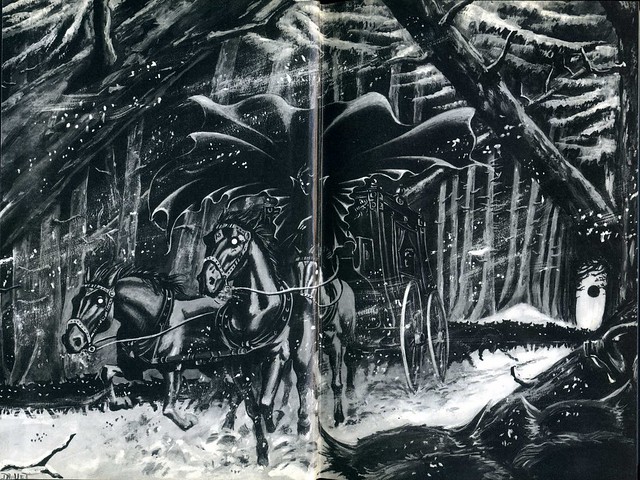





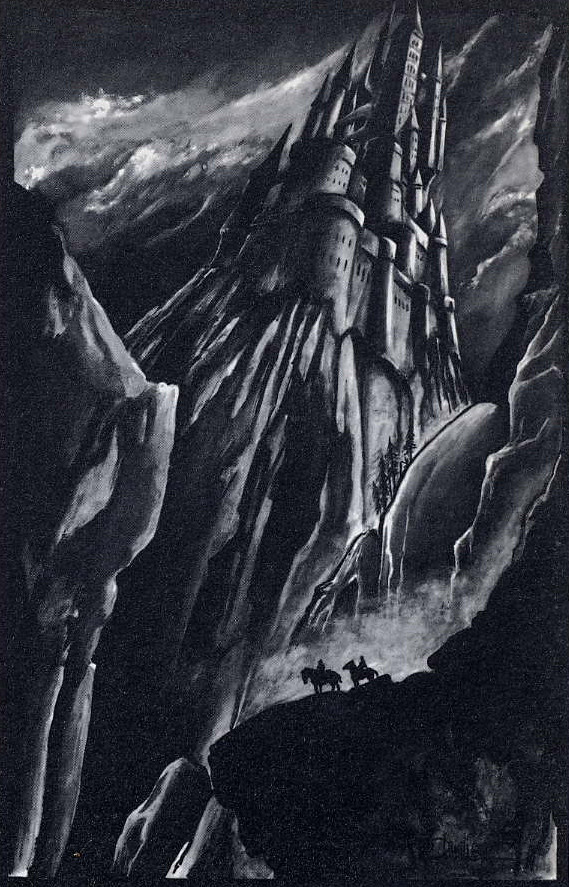

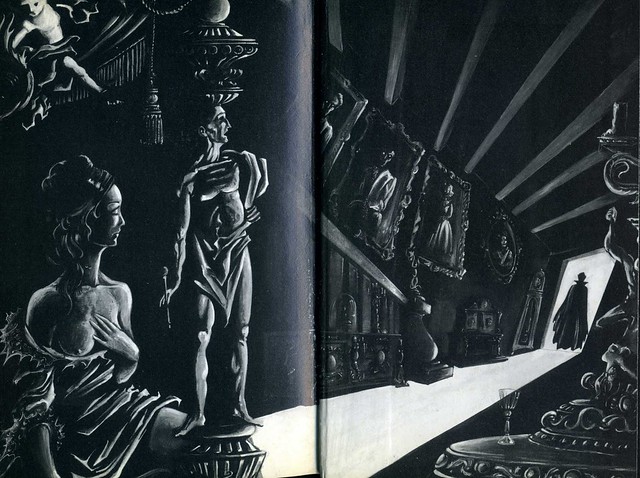

"In 1968 Opta published this Dracula edition. Limited to 3700 copies and illustrated by the young (24 years old at this time) and already talented Philippe Druillet." - quote and many of these images taken from deadlicious.
Other images found at bxzzines. Beware that bxzzines and deadlicious contain not safe for work material.
Visit Philippe's official site here to see more of his art.
A Commonsense Solar Defense
by Jeff Gates
December 29 2010
Three days before Christmas, the U.S. Congress authorized $725 billion in defense spending for 2011. Adjusted for inflation, that’s the most since 1945, the last year of World War II.
With numbers that large, making comparisons is difficult. Yet consider this. The United Nations reports that 1.5 billion people still live without electricity. For less than $100, a solar panel can power a cell phone charger and four high-efficiency LED lights.
At that price, 1.5 billion people could become partially electrified for $150 billion. Defense-wise, which taxpayer outlay offers better long-term security?
With the U.S. humbled in Iraq, mired in Afghanistan and in danger of being drawn into Iran, is it time to replace aggression with development and firepower with solar power?
With extremism the new enemy, what’s our best defense? What if the U.S. projected its power by defending against the indignities of energy poverty and illiteracy?
Absent a strategy for addressing the roots of human indignity, it’s not clear that the war on terrorism can be won. Energy poverty is a war we know how to win.
Parents of children using solar-powered LED lights report how their grades improve when they have light for studying. While that’s not enough, it’s a good start.
Can the U.S. afford not to embrace a solar defense? If not literacy, what is the best long-term defense against extremism? For $12, a solar-powered LED system can power a desk lamp and a phone charger.
As yet, there is no business model for home-scale solar systems scattered across a continent. Large-scale solar projects are far easier to finance. Community-scale is where the Pentagon can play an immediate role.
A New Form of Defense
Women living in the Pashtun area between Pakistan and Afghanistan share similar goals. They want to charge their cell phones, power a few light bulbs and refrigerate their food.
That’s a challenge the Pentagon can meet. Solar panels can handle part of that task though not all. But again, that’s a good start. Widespread access to cell phones is also helpful.
Cell phones are fast becoming a key tool for transferring money in developing countries. Transactions seldom exceed $20. By improving personal communications, they also provide another incentive to electrify in order to recharge the phone.
Phones now feature applications able to facilitate distance education, coordinate testing and track student progress. What would be the impact of literacy and electrification on the long-term need for weapons-based defense spending? Is the enemy terrorism or indignity?
Cold War defense outlays totaled $20 trillion (in 2010 dollars) from 1948 until the fall of the Berlin Wall in 1989. The Clinton administration spent roughly $4 trillion. Republican G.W. Bush spent another $4.65 trillion and Democrat Barack Obama is on track to spend $5 trillion. That’s a 63-year bipartisan total of at least $33,650,000,000,000 ($33.65 trillion).
How many educations could that have financed? How many homes electrified? How many schools built? How much poverty eradicated? U.S. defense spending from 1998 through 2011 will total $7.2 trillion. What will we have to show for it?
In Defense of Empathy
Conventional defense strategy assumes we are hard-wired for aggression, violence and a radical self-interest. Yet research suggests we’re soft-wired for sociability, empathy and a drive to belong.
What is the best long-term defense against those who view us as The Other? Answer: a strategy that demonstrates U.S. sincerity in enhancing the capacity of others to flourish. Community is the relevant scale for such an initiative.
Though national governments can help coordinate, the impact must be felt at the level of the family and the neighborhood. Address unmet needs there and the impact will suppress secondary drives such as violence and aggression.
To ensure extremism, fail to address the insecurity of poverty and the vulnerability of illiteracy. An empathy strategy is the missing piece in the national security puzzle.
By demonstrating that America sees others as sojourners rather than enemies, the U.S. prepares the groundwork for lasting peace. To win at The Clash of Civilizations, Americans must show by their conduct how to create a truly empathetic civilization.
You can’t fake it. Either people have electricity or not. Their children can read and write or they cannot. Either commerce is enabled in ways relevant to communities—or not.
While it’s easy to kill, creation requires a long-term commitment. Absent an empathy component, what will change at the end of the next six decades of defense expenditures?
The U.S. can no longer afford $725 billion each year for defense, much of it borrowed. Given the poor return on our investment, it’s clear we need another strategy, one free of Zionist goals that advance behind serial conflicts and the debt incurred to fund them.
We know what to do. What’s required is the leadership to do it.
Jeff Gates is author of Guilt By Association – How Deception and Self-Deceit Took America to War. See www.criminalstate.com
With numbers that large, making comparisons is difficult. Yet consider this. The United Nations reports that 1.5 billion people still live without electricity. For less than $100, a solar panel can power a cell phone charger and four high-efficiency LED lights.
At that price, 1.5 billion people could become partially electrified for $150 billion. Defense-wise, which taxpayer outlay offers better long-term security?
With the U.S. humbled in Iraq, mired in Afghanistan and in danger of being drawn into Iran, is it time to replace aggression with development and firepower with solar power?
With extremism the new enemy, what’s our best defense? What if the U.S. projected its power by defending against the indignities of energy poverty and illiteracy?
Absent a strategy for addressing the roots of human indignity, it’s not clear that the war on terrorism can be won. Energy poverty is a war we know how to win.
Parents of children using solar-powered LED lights report how their grades improve when they have light for studying. While that’s not enough, it’s a good start.
Can the U.S. afford not to embrace a solar defense? If not literacy, what is the best long-term defense against extremism? For $12, a solar-powered LED system can power a desk lamp and a phone charger.
As yet, there is no business model for home-scale solar systems scattered across a continent. Large-scale solar projects are far easier to finance. Community-scale is where the Pentagon can play an immediate role.
A New Form of Defense
Women living in the Pashtun area between Pakistan and Afghanistan share similar goals. They want to charge their cell phones, power a few light bulbs and refrigerate their food.
That’s a challenge the Pentagon can meet. Solar panels can handle part of that task though not all. But again, that’s a good start. Widespread access to cell phones is also helpful.
Cell phones are fast becoming a key tool for transferring money in developing countries. Transactions seldom exceed $20. By improving personal communications, they also provide another incentive to electrify in order to recharge the phone.
Phones now feature applications able to facilitate distance education, coordinate testing and track student progress. What would be the impact of literacy and electrification on the long-term need for weapons-based defense spending? Is the enemy terrorism or indignity?
Cold War defense outlays totaled $20 trillion (in 2010 dollars) from 1948 until the fall of the Berlin Wall in 1989. The Clinton administration spent roughly $4 trillion. Republican G.W. Bush spent another $4.65 trillion and Democrat Barack Obama is on track to spend $5 trillion. That’s a 63-year bipartisan total of at least $33,650,000,000,000 ($33.65 trillion).
How many educations could that have financed? How many homes electrified? How many schools built? How much poverty eradicated? U.S. defense spending from 1998 through 2011 will total $7.2 trillion. What will we have to show for it?
In Defense of Empathy
Conventional defense strategy assumes we are hard-wired for aggression, violence and a radical self-interest. Yet research suggests we’re soft-wired for sociability, empathy and a drive to belong.
What is the best long-term defense against those who view us as The Other? Answer: a strategy that demonstrates U.S. sincerity in enhancing the capacity of others to flourish. Community is the relevant scale for such an initiative.
Though national governments can help coordinate, the impact must be felt at the level of the family and the neighborhood. Address unmet needs there and the impact will suppress secondary drives such as violence and aggression.
To ensure extremism, fail to address the insecurity of poverty and the vulnerability of illiteracy. An empathy strategy is the missing piece in the national security puzzle.
By demonstrating that America sees others as sojourners rather than enemies, the U.S. prepares the groundwork for lasting peace. To win at The Clash of Civilizations, Americans must show by their conduct how to create a truly empathetic civilization.
You can’t fake it. Either people have electricity or not. Their children can read and write or they cannot. Either commerce is enabled in ways relevant to communities—or not.
While it’s easy to kill, creation requires a long-term commitment. Absent an empathy component, what will change at the end of the next six decades of defense expenditures?
The U.S. can no longer afford $725 billion each year for defense, much of it borrowed. Given the poor return on our investment, it’s clear we need another strategy, one free of Zionist goals that advance behind serial conflicts and the debt incurred to fund them.
We know what to do. What’s required is the leadership to do it.
Jeff Gates is author of Guilt By Association – How Deception and Self-Deceit Took America to War. See www.criminalstate.com
Anniversary of Wounded Knee, birthday remembered
December 29 has always been an easy date to note: my dad would have been 91 today.
For two boys growing up in South Dakota, one attending a single-room schoolhouse and one a Catholic grade school, this day on the calendar had no other significance (Do you remember it being taught?). It was not until college that this student learned it represented the most heinous event in South Dakota history:
One of the first jobs we kids learned after moving to the farm in the Spring of '64 was picking rock. I was almost ten, sister Lynn was eight. We learned to drive taking turns at the wheel of that old tractor and wagon moving at a half a mile an hour while Dad did most of the real work.
Finding stone hammers was our reward for clearing glacial till from those fields not knowing that they had been left there by the ancestors of those killed at Wounded Knee. Blood from our oft-smashed fingers are still on some of those rocks.
Happy Birthday, Papa.
For two boys growing up in South Dakota, one attending a single-room schoolhouse and one a Catholic grade school, this day on the calendar had no other significance (Do you remember it being taught?). It was not until college that this student learned it represented the most heinous event in South Dakota history:
At daybreak on December 29, 1890, Col. Forsyth ordered the surrender of weapons and the immediate removal and transportation of the Indians from the "zone of military operations" to awaiting trains. Specific details of what triggered the fight are debated. According to some accounts, a medicine man named Yellow Bird began to perform the Ghost Dance, reiterating his assertion to the Lakota that the ghost shirts were bulletproof. As tension mounted, Black Coyote refused to give up his rifle; he was deaf and had not understood the order.The narrative that follows that passage is too horrifying to appear here.
One of the first jobs we kids learned after moving to the farm in the Spring of '64 was picking rock. I was almost ten, sister Lynn was eight. We learned to drive taking turns at the wheel of that old tractor and wagon moving at a half a mile an hour while Dad did most of the real work.
Finding stone hammers was our reward for clearing glacial till from those fields not knowing that they had been left there by the ancestors of those killed at Wounded Knee. Blood from our oft-smashed fingers are still on some of those rocks.
Happy Birthday, Papa.
pitchers tuck by buddy don: them cats
i promissd yesterdy that i wood putt up a cuple pitchers of them other critters besides Kingsley that lives with us. furst up is a verr speshul yung lady name of Miss Liberty. we gut her frum the Liberty Harbor Animal Shelter, witch miz bd tuck it into her hed that ifn we had us a cat, mayhap Kingsley wood have a lil more innerestin life. he wuz born in a puppy mill in South Carolina n saved by a
Tuesday, December 28, 2010
A Variety Of Fantasy Illustrations
 JOSH KIRBY - THE INTERPRETER
JOSH KIRBY - THE INTERPRETER POUL ANDERSON - THREE HEARTS AND THREE LIONS
POUL ANDERSON - THREE HEARTS AND THREE LIONS IAN MILLER - THE WEREWOLF PRINCIPLE
IAN MILLER - THE WEREWOLF PRINCIPLE TERRY OAKES - CHIKSTHA VARIETIES
TERRY OAKES - CHIKSTHA VARIETIES DARRELL SWEET - RED PLANET
DARRELL SWEET - RED PLANET JIM BURNS - FIRST CONTACT
JIM BURNS - FIRST CONTACT ROGER DEAN - BLUE DEMON
ROGER DEAN - BLUE DEMON ROGER DEAN - PALADIN
ROGER DEAN - PALADIN TERRY OAKES - SANDWORM AND RIDER
TERRY OAKES - SANDWORM AND RIDER TONY ROBERTS - STORM DEBRIS ON MESKLIN
TONY ROBERTS - STORM DEBRIS ON MESKLINImages found at the excellent SKI FFY blog.
Subscribe to:
Posts (Atom)







